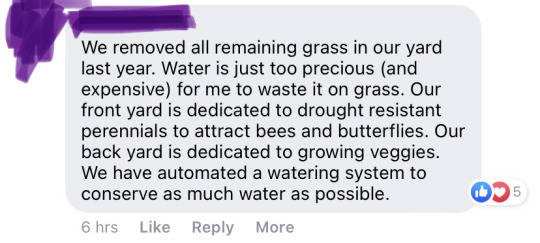i ramble about architecture sometimesmain - @solarpunkladybird
Don't wanna be here? Send us removal request.
Text
"People have been telling stories about renewable energy since the nineteen-seventies, when the first all-solar-powered house opened on the campus of the University of Delaware, drawing a hundred thousand visitors in 1973, its first year, to marvel at its early photovoltaic panels and its solar hot-water system, complete with salt tubs in the basement to store heat overnight. But, even though we’ve got used to seeing solar panels and wind turbines across the landscape in the intervening fifty years, we continue to think of what they produce as “alternative energy,” a supplement to the fossil-fuelled power that has run Western economies for more than two centuries. In the past two years, however, with surprisingly little notice, renewable energy has suddenly become the obvious, mainstream, cost-efficient choice around the world. Against all the big bad things happening on the planet (and despite all the best efforts of the Republican-led Congress in recent weeks), this is a very big and hopeful thing, which a short catalogue of recent numbers demonstrates:
It took from the invention of the photovoltaic solar cell, in 1954, until 2022 for the world to install a terawatt of solar power; the second terawatt came just two years later [in 2024], and the third will arrive either later this year or early next [in 2025 or early 2026].
That’s because people are now putting up a gigawatt’s worth of solar panels, the rough equivalent of the power generated by one coal-fired plant, every fifteen hours. Solar power is now growing faster than any power source in history, and it is closely followed by wind power—which is really another form of energy from the sun, since it is differential heating of the earth that produces the wind that turns the turbines.
Last year, ninety-six per cent of the global demand for new electricity was met by renewables, and in the United States ninety-three per cent of new generating capacity came from solar, wind, and an ever-increasing variety of batteries to store that power.
In March, for the first time, fossil fuels generated less than half the electricity in the U.S. In California, at one point on May 25th, renewables were producing a record hundred and fifty-eight per cent of the state’s power demand. Over the course of the entire day, they produced eighty-two per cent of the power in California, which, this spring, surpassed Japan to become the world’s fourth-largest economy.
Meanwhile, battery-storage capability has increased seventy-six per cent, based on this year’s projected estimates; at night, those batteries are often the main supplier of California’s electricity. As the director of reliability analysis at the North American Electric Reliability Corporation put it, in the CleanTechnica newsletter, “batteries can smooth out some of that variability from those times when the wind isn’t blowing or the sun isn’t shining.” As a result, California is so far using forty per cent less natural gas to generate electricity than it did in 2023, which is the single most hopeful statistic I’ve seen in four decades of writing about the climate crisis.
Texas is now installing renewable energy and batteries faster than California; in a single week in March, it set records for solar and wind production as well as for battery discharge. In May, when the state was hit by a near-record-breaking early-season heat wave, air-conditioners helped create a record demand on the grid, which didn’t blink—more than a quarter of the power came from the sun and wind. Last week’s flooding tragedy was a reminder of how vulnerable the state is to extreme weather, especially as water temperatures rise in the Gulf, producing more moisture in the air; in late June, the director of the state’s utility system said that the chances of emergency outages had dropped from sixteen per cent last summer to less than one per cent this year, mostly because the state had added ten thousand megawatts of solar power and battery storage. That, he said, “puts us in a better position.”
All this is dwarfed by what’s happening in China, which currently installs more than half the world’s renewable energy and storage within its own borders, and exports most of the solar panels and batteries used by the rest of the world. In May, according to government records, China had installed a record ninety-three gigawatts of solar power—amounting to a gigawatt every eight hours. The pace was apparently paying off—analysts reported that, in the first quarter of the year, total carbon emissions in China had actually decreased; emissions linked to producing electricity fell nearly six per cent, as solar and wind have replaced coal. In 2024, almost half the automobiles sold in China, which is the world’s largest car market, were full or hybrid electric vehicles. And China’s prowess at producing cheap solar panels (and E.V.s) means that nations with which it has strong trading links—in Asia, Africa, South America—are seeing their own surge of renewable power.
In South America, for example, where a decade ago there were plans to build fifteen new coal-fired power plants, as of this spring there are none. There’s better news yet from India, now the world’s fastest-growing major economy and most populous nation, where data last month showed that from January through April a surge in solar production kept the country’s coal use flat and also cut the amount of natural gas used during the same period in 2024 by a quarter. But even countries far from Beijing are making quick shifts. Poland—long a leading coal-mining nation—saw renewable power outstrip coal for electric generation in May, thanks to a remarkable surge in solar construction. In 2021, the country set a goal for photovoltaic power usage by 2030; it has already tripled that goal.
Over the past fifteen years, the Chinese became so skilled at building batteries—first for cellphones, then cars, and now for entire electric systems—that the cost of energy storage has dropped ninety-five per cent. On July 7th, a round of bidding between battery companies to provide storage for Chinese utilities showed another thirty per cent drop in price. Grid-scale batteries have become so large that they can power whole cities for hours at a time; in 2025, the world will add eighty gigawatts of grid-scale storage, an eightfold increase from 2021. The U.S. alone put up four gigawatts of storage in the first half of 2024.
There are lots of other technologies vying to replace fossil fuels or to reduce climate damage: nuclear power, hydrogen power, carbon capture and storage; along with renewables, all were boosted by spending provisions in Biden’s Inflation Reduction Act and will be hampered to varying degrees by congressional rollbacks. Some may prove useful in the long run and others illusory, but for now they are statistically swamped by the sheer amount of renewable power coming online. Globally, roughly a third more power is being generated from the sun this spring than last. If this exponential rate of growth can continue, we will soon live in a very different world.
All this suggests that there is a chance for a deep reordering of the earth’s power systems, in every sense of the word “power,” offering a plausible check to not only the climate crisis but to autocracy. Instead of relying on scattered deposits of fossil fuel—the control of which has largely defined geopolitics for more than a century—we are moving rapidly toward a reliance on diffuse but ubiquitous sources of supply. The sun and the wind are available everywhere, and they complement each other well; when sunlight diminishes in the northern latitudes at the approach of winter, the winds pick up. This energy is impossible to hoard and difficult to fight wars over. If you’re interested in abundance, the sun beams tens of thousands of times more energy at the earth than we currently need. Paradigm shifts like this don’t come along often: the Industrial Revolution, the computer revolution. But, when they do, they change the world in profound and unpredictable ways...
In retrospect, it’s reasonably easy to see how fast solar and wind power were coming. But, blinkered by the status quo, almost no one actually predicted it. In 2009, the International Energy Agency predicted that we would hit two hundred and forty-four gigawatts of solar capacity by 2030; we hit it by 2015. For most of the past decade, the I.E.A.’s five-year forecasts missed [underestimated the amount of renewables] by an average of two hundred and thirty-five per cent. The only group that came even remotely close to getting it right was not J. P. Morgan Chase or Dow Jones or BlackRock. It was Greenpeace, which estimated in 2009 that we’d hit nine hundred and twenty-one total gigawatts by 2030. We were more than fifty per cent above that by 2023. Last summer, Jenny Chase, who has been tracking the economics of solar power for more than two decades for Bloomberg, told the Times, “If you’d told me nearly 20 years ago what would be the case now, 20 years later, I would have just said you were crazy. I would have laughed in your face. There is genuinely a revolution happening.”
-via The New Yorker, July 9, 2025
3K notes
·
View notes
Text
There should totally be a movement called “Sleep in Public” where people defend their right to sleep on public property. Sleep in your cars. Sleep on benches. Sleep at the park. Just make it a mundane and regular part of life to see someone napping in the library. It would make it much harder to single out the homeless for harassment if everyone else is doing the same thing and much harder to argue that it’s a “threat to public safety” when it’s so clearly harmless.
126K notes
·
View notes
Text
I was working with an item today that just utterly flabbergasted a part of me (the other was deeply frustrated with the catalogue record AS SOMEONE APPARENTLY THOUGHT IT WAS PRINTED ON SILK, coming back to that in a minute) … but ANYWAYS … said item is a replica of a medieval manuscript prayer book THAT IS ENTIRELY WOVEN out of grey and black silk … WOVEN … text, images, intricate grey scale, WOVEN … NOT PRINTED …
And it’s flabbergasting because it’s from 1888, Jacquard machine, IT USED PUNCH CARDS to weave these intricate pages … something like 400 weft per near square inch … IT looks like a page of textured paper, but it’s not, it’s entirely SILK … F*CK …
Anyways …
41K notes
·
View notes
Text

Or water fountains, public washrooms, outdoors tables, etc, etc
165K notes
·
View notes
Photo

“Pierre philosophale” (2013) by Les frères Chapuisat - A stone sculpture humorously juxtaposes a cigarette within a rock’s slit, blending natural form with human artifact.
25K notes
·
View notes
Text
RIP Richard Serra. You made so many people so so so mad
22K notes
·
View notes
Text
They recorded tinnitus? It's a physical thing?????
67K notes
·
View notes
Text
50K notes
·
View notes
Text
Tumblr is super big on the "I didn't say it was good, I said I liked it" but really need to discover the value in its opposite of "I didn't say it was bad, I said I hated it".
You can acknowledge that something is good, great, a masterpiece even, and just straight-up not enjoy it.
48K notes
·
View notes
Text
Mom sent me a facebook link to a PBS news hour post about how the anti-lawn movement is growing. The vast majority of the comments on it were stuff like this:








Most people are on our side here, even the so-called "boomers." We just have to be spreading ecological knowledge and practical means of creating useful habitat in back yards! Educate! Protect! Resist!
85K notes
·
View notes
Text

Illustration from Documents Decoratifs by Alphonse Mucha (1901)
1K notes
·
View notes
Text
"In an unprecedented transformation of China’s arid landscapes, large-scale solar installations are turning barren deserts into unexpected havens of biodiversity, according to groundbreaking research from the Chinese Academy of Sciences. The study reveals that solar farms are not only generating clean energy but also catalyzing remarkable ecological restoration in some of the country’s most inhospitable regions.
The research, examining 40 photovoltaic (PV) plants across northern China’s deserts, found that vegetation cover increased by up to 74% in areas with solar installations, even in locations using only natural restoration measures. This unexpected environmental dividend comes as China cements its position as the global leader in solar energy, having added 106 gigawatts of new installations in 2022 alone.
“Artificial ecological measures in the PV plants can reduce environmental damage and promote the condition of fragile desert ecosystems,” says Dr. Benli Liu, lead researcher from the Chinese Academy of Sciences. “This yields both ecological and economic benefits.”
The economic implications are substantial. “We’re witnessing a paradigm shift in how we view desert solar installations,” says Professor Zhang Wei, environmental economist at Beijing Normal University. “Our cost-benefit analysis shows that while initial ecological construction costs average $1.5 million per square kilometer, the long-term environmental benefits outweigh these investments by a factor of six within just a decade.” ...
“Soil organic carbon content increased by 37.2% in areas under solar panels, and nitrogen levels rose by 24.8%,” reports Dr. Sarah Chen, soil scientist involved in the project. “These improvements are crucial indicators of ecosystem health and sustainability.”
...Climate data from the study sites reveals significant microclimate modifications:
Average wind speeds reduced by 41.3% under panel arrays
Soil moisture retention increased by 32.7%
Ground surface temperature fluctuations decreased by 85%
Dust storm frequency reduced by 52% in solar farm areas...
The scale of China’s desert solar initiative is staggering. As of 2023, the country has installed over 350 gigawatts of solar capacity, with 30% located in desert regions. These installations cover approximately 6,000 square kilometers of desert terrain, an area larger than Delaware.
“The most surprising finding,” notes Dr. Wang Liu of the Desert Research Institute, “is the exponential increase in insect and bird species. We’ve documented a 312% increase in arthropod diversity and identified 27 new bird species nesting within the solar farms between 2020 and 2023.”
Dr. Yimeng Wang, the study’s lead author, emphasizes the broader implications: “This study provides evidence for evaluating the ecological benefit and planning of large-scale PV farms in deserts.”
The solar installations’ positive impact stems from several factors. The panels act as windbreaks, reducing erosion and creating microhabitats with lower evaporation rates. Perhaps most surprisingly, the routine maintenance of these facilities plays a crucial role in the ecosystem’s revival.
“The periodic cleaning of solar panels, occurring 7-8 times annually, creates consistent water drip lines beneath the panels,” explains Wang. “This inadvertent irrigation system promotes vegetation growth and the development of biological soil crusts, essential for soil stability.” ...
Recent economic analysis reveals broader benefits:
Job creation: 4.7 local jobs per megawatt of installed capacity
Tourism potential: 12 desert solar sites now offer educational tours
Agricultural integration: 23% of sites successfully pilot desert agriculture beneath panels
Carbon reduction: 1.2 million tons CO2 equivalent avoided per gigawatt annually
Dr. Maya Patel, visiting researcher from the International Renewable Energy Agency, emphasizes the global implications: “China’s desert solar model could be replicated in similar environments worldwide. The Sahara alone could theoretically host enough solar capacity to meet global electricity demand four times over while potentially greening up to 20% of the desert.”
The Chinese government has responded by implementing policies promoting “solar energy + sand control” and “solar energy + ecological restoration” initiatives. These efforts have shown promising results, with over 92% of PV plants constructed since 2017 incorporating at least one ecological construction mode.
Studies at facilities like the Qinghai Gonghe Photovoltaic Park demonstrate that areas under solar panels score significantly better in environmental assessments compared to surrounding regions, indicating positive effects on local microclimates.
As the world grapples with dual climate and biodiversity crises, China’s desert solar experiment offers a compelling model for sustainable development. The findings suggest that renewable energy infrastructure, when thoughtfully implemented, can serve as a catalyst for environmental regeneration, potentially transforming the world’s deserts from barren wastelands into productive, life-supporting ecosystems.
“This is no longer just about energy production,” concludes Dr. Liu. “We’re witnessing the birth of a new approach to ecosystem rehabilitation that could transform how we think about desert landscapes globally. The next decade will be crucial as we scale these solutions to meet both our climate and biodiversity goals.”"
-via Green Fingers, January 13, 2025
2K notes
·
View notes
Text

The Historical Merchant's Hall in Freiburg
Germany
83 notes
·
View notes



